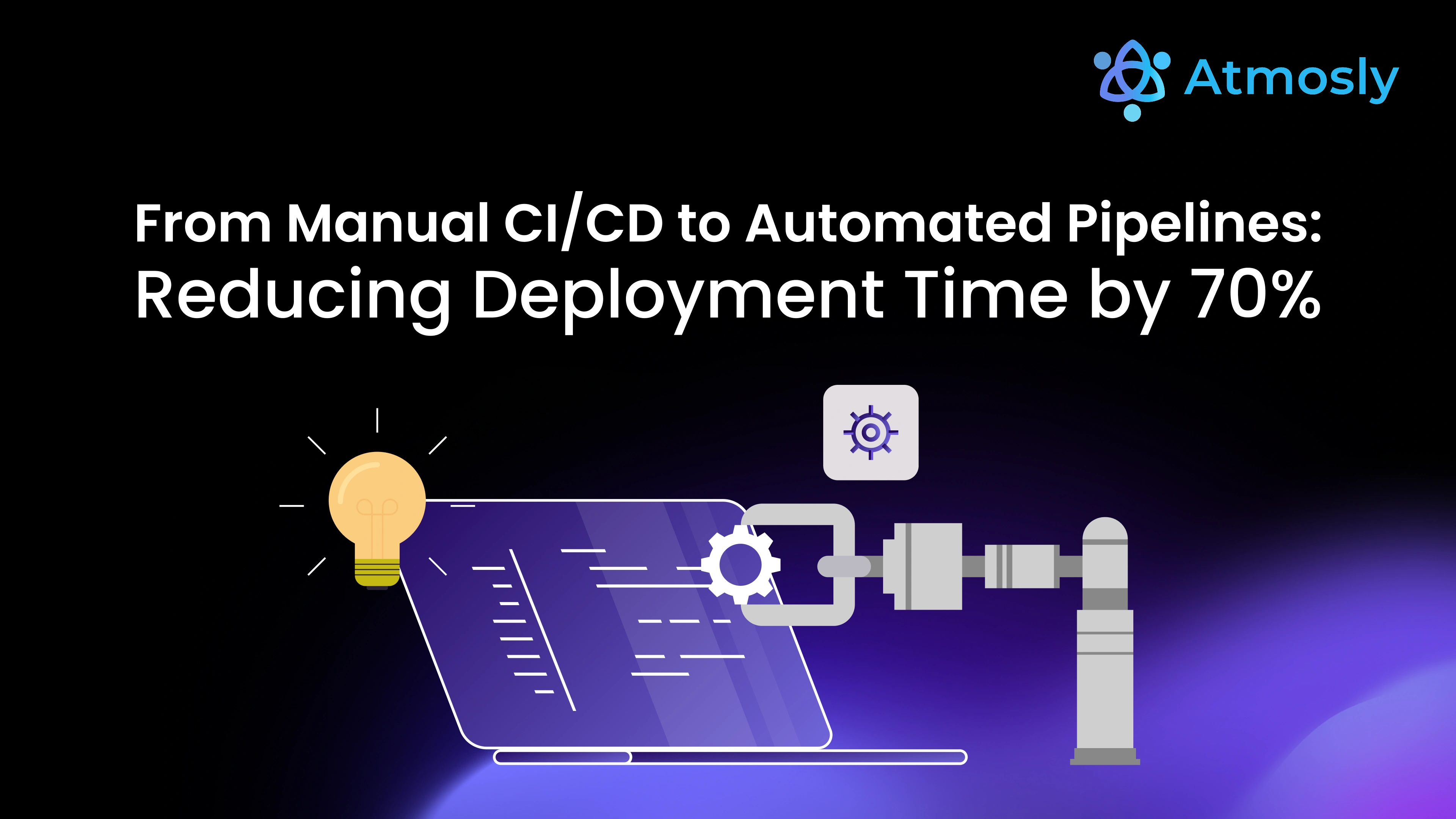Speed, reliability, and repeatability are the pillars of modern software delivery. Yet, many engineering teams are still stuck managing manual CI/CD pipelines that rely on human intervention, long approval chains, and fragile scripts.
In a world where top-performing organizations deploy hundreds of times a day, traditional approaches can’t keep up.
That’s why more companies are adopting automated CI/CD pipelines, transforming their delivery processes to achieve faster, safer, and more consistent releases.
In this blog, we’ll explore how automated pipelines work, their key benefits, and how teams can reduce deployment time by up to 70% through smart automation.
What Is CI/CD and Why It Matters
Continuous Integration (CI) and Continuous Delivery (CD) form the backbone of DevOps automation.
- Continuous Integration automates code integration, testing, and validation whenever developers push updates.
- Continuous Delivery/Deployment automates packaging, deployment, and release processes into staging or production environments.
Together, they ensure that software can reliably and frequently move from code to production without manual friction.
But in many organizations, these processes still involve human approvals, manual triggers, or custom scripts that are hard to maintain. That’s where automation changes everything.
The Problem with Manual CI/CD Pipelines
Manual pipelines may seem manageable for small teams, but as systems scale, they quickly become a bottleneck.
Common Issues Include:
Inconsistent environments: Manual deployments often fail due to mismatched dependencies.
Human errors: A missed command or incorrect configuration can cause downtime.
Slower releases: Manual QA, approvals, and staging prolong time-to-market.
Poor scalability: Multi-service, multi-environment systems are nearly impossible to manage manually.
Manual CI/CD doesn’t just slow down delivery, it kills developer productivity and increases the risk of deployment failures.
The Shift Toward Automation in 2025
As organizations embrace microservices and multi-cloud environments, automation has become essential.
Automated CI/CD pipelines use tools like GitHub Actions, ArgoCD, Tekton, or GitLab CI to create self-running workflows triggered by code changes, merges, or releases.
These pipelines integrate automated testing, security scanning, deployment, and rollback, allowing teams to release software continuously and confidently.
In 2025, automation isn’t just a DevOps best practice, it’s the default approach for every scalable engineering team.
How Automated Pipelines Reduce Deployment Time by 70%
1. Automated Testing and Validation
Automated pipelines run unit, integration, and end-to-end tests on every commit, ensuring code stability without waiting for manual QA approval.
Impact: Detects bugs early and shortens feedback loops.
2. Parallel and Incremental Builds
Modern CI/CD tools build and test code in parallel, reducing build times from hours to minutes.
Impact: Dramatic reduction in overall pipeline execution time.
3. Continuous Deployment
Instead of manual handoffs, deployments are triggered automatically after successful validation.
Impact: Immediate release to staging or production environments with rollback support.
4. Self-Healing Pipelines
AI-driven systems detect failed jobs and auto-retry or roll back deployments, minimizing downtime.
Impact: Fewer incidents, faster recovery.
5. Infrastructure as Code (IaC) Integration
By integrating Terraform or Helm, infrastructure provisioning becomes part of the pipeline itself.
Impact: Zero manual setup, consistent environments every time.
6. Observability and Feedback Loops
Real-time monitoring and analytics tools provide instant visibility into build performance and deployment health.
Impact: Faster root cause analysis and continuous improvement.
Together, these automation layers create a 70% faster delivery pipeline with fewer errors and higher confidence in every release.
Key Benefits of Automated CI/CD Pipelines
1. Speed and Agility
Faster iterations mean teams can release new features, fixes, and experiments multiple times a day.
2. Reliability
Automated validation ensures every release passes through consistent quality gates before deployment.
3. Cost Efficiency
Reduced manual intervention frees engineering hours and minimizes downtime.
4. Scalability
Automation allows CI/CD pipelines to handle multiple services, environments, and teams simultaneously.
5. Developer Satisfaction
Developers focus on building products, not maintaining pipelines or resolving deployment issues.
High-performing DevOps teams deploy 200x more frequently with 24x faster recovery times automation makes that possible.
Core Components of an Automated CI/CD Pipeline
Version Control Integration – Automatically triggers pipelines on code commits or pull requests.
Automated Testing – Unit, integration, and security tests integrated into workflows.
Artifact Management – Store and manage build outputs (e.g., Docker images, binaries).
Automated Deployment – Use Helm, ArgoCD, or Terraform to deploy to cloud or Kubernetes environments.
Monitoring & Alerts – Use Prometheus, Grafana, or Datadog for pipeline observability
Rollback & Recovery – Automatic reversion to last stable version upon failure.
Top CI/CD Automation Tools in 2025
Tool | Best For | Key Features |
GitHub Actions | Integration with GitHub projects | Simple YAML workflows, cloud runners |
GitLab CI/CD | End-to-end CI/CD automation | Built-in pipelines, security scanning |
ArgoCD | Kubernetes-native CD | GitOps-based deployments, rollback support |
Tekton | Custom, open-source CI/CD | Cloud-native pipeline building blocks |
CircleCI | SaaS-based CI/CD | Fast parallel builds, flexibility for startups |
Jenkins X | Open-source automation | Extensible plugins, Kubernetes-ready pipelines |
Tip: The best CI/CD tool depends on your team’s size, infrastructure, and deployment model not all pipelines need to be complex.
How to Transition from Manual to Automated CI/CD
Transitioning to automation requires both technical and cultural shifts.
Step 1: Standardize Your Pipeline Templates
Create reusable pipeline blueprints for builds, tests, and deployments.
Step 2: Integrate Automated Testing Early
Shift-left testing ensures that code quality issues are caught in CI, not after deployment.
Step 3: Embrace Infrastructure as Code (IaC)
Automate your environments using Terraform or Helm to ensure reproducibility.
Step 4: Introduce GitOps Principles
Manage deployment states declaratively through Git ensuring version control for infrastructure.
Step 5: Implement Continuous Monitoring
Track performance, failure rates, and build duration metrics for continuous optimization.
Start small automate one service, validate, then scale across teams.
The Future of CI/CD Automation
The next generation of CI/CD automation is becoming intelligent, self-healing, and AI-driven.
Here’s what to expect in 2025 and beyond:
AI-Assisted Pipelines: Predict failures before they occur and automatically suggest fixes.
Multi-Cloud Delivery: Unified pipelines deploying seamlessly across AWS, GCP, and Azure.
Continuous Verification: Automated post-deployment testing for real-time validation.
Adaptive Scaling: Automatically adjust resources based on build and traffic patterns.
Automation isn’t replacing engineers it’s empowering them to move faster, safer, and smarter.
Conclusion:
Manual pipelines belong to the past.
With automated CI/CD, teams eliminate repetitive work, improve release frequency, and gain full control over their delivery process.
By standardizing pipelines, integrating IaC, and adopting GitOps, organizations can cut deployment times by up to 70% freeing developers to focus on innovation, not configuration.
The future of DevOps belongs to teams that automate, measure, and continuously improve one pipeline at a time.






